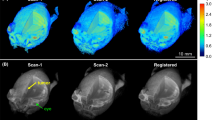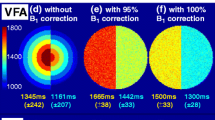Abstract
Dynamic contrast-enhanced magnetic resonance imaging (DCE-MRI) is a well-established technique for studying blood–brain barrier (BBB) permeability that allows measurements to be made for a wide range of brain pathologies, including multiple sclerosis and brain tumors (BT). This latter application is particularly interesting, because high-grade gliomas are characterized by increased microvascular permeability and a loss of BBB function due to the structural abnormalities of the endothelial layer. In this study, we compared the extended Tofts-Kety (ETK) model and an extended derivate class from phenomenological universalities called EU1 in 30 adult patients with different BT grades. A total of 75 regions of interest were manually drawn on the MRI and subsequently analyzed using the ETK and EU1 algorithms. Significant linear correlations were found among the parameters obtained by these two algorithms. The means of R 2 obtained using ETK and EU1 models for high-grade tumors were 0.81 and 0.91, while those for low-grade tumors were 0.82 and 0.85, respectively; therefore, these two models are equivalent. In conclusion, we can confirm that the application of the EU1 model to the DCE-MRI experimental data might be a useful alternative to pharmacokinetic models in the study of BT, because the analytic results can be generated more quickly and easily than with the ETK model.



Similar content being viewed by others
References
Gaitan MI, Shea CD, Evangelou IE, Stone RD, Fenton KM, Bielekova B, Massacesi L, Reich DS: Evolution of the blood–brain barrier in newly forming multiple sclerosis lesions. Ann Neurol 70:22–29, 2011
Lund H, Krakauer M, Skimminge A, Sellebjerg F, Garde E, Siebner HR, Paulson OB, Hesse D, Hanson LG: Blood–brain barrier permeability of normal appearing white matter in relapsing-remitting multiple sclerosis. PLoS One 8:e56375, 2013
Taheri S, Gasparovic C, Huisa BN, Adair JC, Edmonds E, Prestopnik J, Grossetete M, Shah NJ, Wills J, Qualls C, Rosenberg GA: Blood–brain barrier permeability abnormalities in vascular cognitive impairment. Stroke 42:2158–2163, 2011
Kassner A, Mandell DM, Mikulis DJ: Measuring permeability in acute ischemic stroke. Neuroimaging Clin N Am 21:315–325, 2011. x-xi
Yuan F, Salehi HA, Boucher Y, Vasthare US, Tuma RF, Jain RK: Vascular permeability and microcirculation of gliomas and mammary carcinomas transplanted in rat and mouse cranial windows. Cancer Res 54:4564–4568, 1994
Bullitt E, Zeng D, Gerig G, Aylward S, Joshi S, Smith JK, Lin W, Ewend MG: Vessel tortuosity and brain tumor malignancy: a blinded study. Acad Radiol 12:1232–1240, 2005
Vick NA, Bigner DD: Microvascular abnormalities in virally induced canine brain tumors. Structural bases for altered blood–brain barrier function. J Neurol Sci 17:29–39, 1972
Yankeelov TE, Gore JC: Dynamic contrast-enhanced magnetic resonance imaging in oncology: theory, data acquisition, analysis, and examples. Curr Med Imaging Rev 3:91–107, 2009
Tofts PS, Brix G, Buckley DL, Evelhoch JL, Henderson E, Knopp MV, Larsson HB, Lee TY, Mayr NA, Parker GJ, Port RE, Taylor J, Weisskoff RM: Estimating kinetic parameters from dynamic contrast-enhanced T (1)-weighted MRI of a diffusable tracer: standardized quantities and symbols. J Magn Reson Imaging 10:223–232, 1999
Buckley DL: Uncertainty in the analysis of tracer kinetics using dynamic contrast-enhanced T1-weighted MRI. Magn Reson Med 47:601–606, 2002
Padhani AR: Dynamic contrast-enhanced MRI in clinical oncology: current status and future directions. J Magn Reson Imaging 16:407–422, 2002
Harrer JU, Parker GJ, Haroon HA, Buckley DL, Embelton K, Roberts C, Baleriaux D, Jackson A: Comparative study of methods for determining vascular permeability and blood volume in human gliomas. J Magn Reson Imaging 20:748–757, 2004
Bergamino M, Saitta L, Barletta L, Bonzano L, Mancardi GL, Castellan L, Ravetti JL, Roccatagliata L: Measurement of blood–brain barrier permeability with T1-weighted dynamic contrast-enhanced MRI in brain tumors: a comparative study with two different algorithms. ISRN Neuroscience 2013:6 pages, 2013
Bergamino M, Bonzano L, Levrero F, Mancardi GL, Roccatagliata L: A review of technical aspects of T-weighted dynamic contrast-enhanced magnetic resonance imaging (DCE-MRI) in human brain tumors. Phys Med, 2014
Fan X, Medved M, Karczmar GS, Yang C, Foxley S, Arkani S, Recant W, Zamora MA, Abe H, Newstead GM: Diagnosis of suspicious breast lesions using an empirical mathematical model for dynamic contrast-enhanced MRI. Magn Reson Imaging 25:593–603, 2007
Gliozzi AS, Mazzetti S, Delsanto PP, Regge D, Stasi M: Phenomenological universalities: a novel tool for the analysis of dynamic contrast enhancement in magnetic resonance imaging. Phys Med Biol 56:573–586, 2011
Mazzetti S, Gliozzi AS, Bracco C, Russo F, Regge D, Stasi M: Comparison between PUN and Tofts models in the quantification of dynamic contrast-enhanced MR imaging. Phys Med Biol 57:8443–8453, 2012
Castorina P, Delsanto PP, Guiot C: Classification scheme for phenomenological universalities in growth problems in physics and other sciences. Phys Rev Lett 96:188701, 2006
Delsanto PP: Universality of nonclassical nonlinearity: applications to non-destructive evaluations and ultrasonics, New York, 2007
Barberis L, Condat CA, Gliozzi AS, Delsanto PP: Concurrent growth of phenotypic features: a phenomenological universalities approach. J Theor Biol 264:123–129, 2010
Delsanto PP, Gliozzi AS, Guiot C: Scaling, growth and cyclicity in biology: a new computational approach. Theor Biol Med Model 5:5, 2008
Louis DN, Ohgaki H, Wiestler OD, Cavenee WK, Burger PC, Jouvet A, Scheithauer BW, Kleihues P: The 2007 WHO classification of tumours of the central nervous system. Acta Neuropathol 114:97–109, 2007
Jenkinson M, Bannister P, Brady M, Smith S: Improved optimization for the robust and accurate linear registration and motion correction of brain images. NeuroImage 17:825–841, 2002
Schabel MC: A unified impulse response model for DCE-MRI. Magn Reson Med 68:1632–1646, 2012
Haase A: Snapshot FLASH MRI. Applications to T1, T2, and chemical-shift imaging. Magn Reson Med 13:77–89, 1990
van Rijswijk CS, Geirnaerdt MJ, Hogendoorn PC, Taminiau AH, van Coevorden F, Zwinderman AH, Pope TL, Bloem JL: Soft-tissue tumors: value of static and dynamic gadopentetate dimeglumine-enhanced MR imaging in prediction of malignancy. Radiology 233:493–502, 2004
Stoyanova R, Huang K, Sandler K, Cho H, Carlin S, Zanzonico PB, Koutcher JA, Ackerstaff E: Mapping tumor hypoxia in vivo using pattern recognition of dynamic contrast-enhanced MRI data. Transl Oncol 5:437–447, 2012
Heller SL, Moy L, Lavianlivi S, Moccaldi M, Kim S: Differentiation of malignant and benign breast lesions using magnetization transfer imaging and dynamic contrast-enhanced MRI. J Magn Reson Imaging 37:138–145, 2013
Franiel T, Hamm B, Hricak H: Dynamic contrast-enhanced magnetic resonance imaging and pharmacokinetic models in prostate cancer. Eur Radiol 21:616–626, 2011
Tofts PS, Kermode AG: Measurement of the blood–brain barrier permeability and leakage space using dynamic MR imaging. 1. Fundamental concepts. Magn Reson Med 17:357–367, 1991
Zhang N, Zhang L, Qiu B, Meng L, Wang X, Hou BL: Correlation of volume transfer coefficient Ktrans with histopathologic grades of gliomas. J Magn Reson Imaging 36:355–363, 2012
Eliat PA, Olivie D, Saikali S, Carsin B, Saint-Jalmes H, de Certaines JD: Can dynamic contrast-enhanced magnetic resonance imaging combined with texture analysis differentiate malignant glioneuronal tumors from other glioblastoma? Neurol Res Int 2012:195176, 2012
Gliozzi AS, Guiot C, Delsanto PP: A new computational tool for the phenomenological analysis of multipassage tumor growth curves. PLoS One 4:e5358, 2009
Gal Y, Mehnert A, Bradley A, McMahon K, Crozier S: An evaluation of four parametric models of contrast enhancement for dynamic magnetic resonance imaging of the breast. Conf Proc IEEE Eng Med Biol Soc 2007:71–74, 2007
Acknowledgment
We thank Dr. Simone Mazzetti (Institute for Cancer Research and Treatment, Candiolo (TO), Italy) for his valuable help with the EU1 algorithm.
Conflicts of Interest
The authors declare that they have no conflicts of interest concerning this article.
Author information
Authors and Affiliations
Corresponding author
Rights and permissions
About this article
Cite this article
Bergamino, M., Barletta, L., Castellan, L. et al. Dynamic Contrast-Enhanced MRI in the Study of Brain Tumors. Comparison Between the Extended Tofts-Kety Model and a Phenomenological Universalities (PUN) Algorithm. J Digit Imaging 28, 748–754 (2015). https://doi.org/10.1007/s10278-015-9788-2
Published:
Issue Date:
DOI: https://doi.org/10.1007/s10278-015-9788-2




